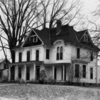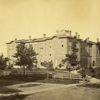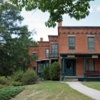Browse Items (44 total)
- Tags: residence hall
Cranford
Cranford was purchased by the College for use as a women's dormitory and dining hall for men and women in 1946 from Mrs. Bertha Pope Cairns. At the time of purchase Cranford housed 43 women and provided board for 82 men and women. The farm estate,…
Burton Hall
Burton Hall was named in honor of trustee and Republican U.S. congressman Theodore Elijah Burton of the Class of 1872. His sister, Mary, married Civil War hero Giles Waldo Shurtleff, a professor, secretary and treasurer, and member of the Board of…
Harkness House
This three-story, mid-20th century dormitory was designed by Eldredge Snyder, who also designed the Jones Field House (demolished) and the Service Building. The front/east facade features a central entry, which has a rounded, projecting bay, which…
Stewart Hall
Stewart Hall was a two-story brick building, used for many years as a private residence. It was first rented by the College in 1880, and was purchased March 10, 1881 at a cost of $5,000, which included an additional lot. Stewart Hall was a dormitory…
Metcalf House
Metcalf House was built in 1908 by Maynard Metcalf, professor of zoology at the college and also the lead expert witness for the defense at the Scopes 'Monkey Trial' in 1925 (University of Missouri-Kansas City School of Law). In about 1909 he built…
La Maison Française (French House)
La Maison Française (French House), was built in 1907 by Dr. Lauderdale, a dentist. He and his wife Mabel, an aspiring artist, ran the house as a student boarding house into the 1920s. Beginning September 1, 1930, the Lauderdale residence was…
Thompson Cottage
The property at 160 North Main Street, privately owned, was purchased by the College in 1913 and equipped as a house of residence for women. From 1913 to 1934 it was known as Keep Annex, furnishing rooming accommodations for sixteen women, who…
Program Houses/Dormitories (1968)
In 1968, eight dormitories were built as program houses: Lord and Saunders (now Afrikan Heritage House), Bailey (French House), Barnard (substance-free), Harvey (Spanish House), Kade (German House), Price (now Third World House), and Zechiel…
West Lodge
From 1927 to 1937, West Lodge at 106 West Lorain Street had been used as an office annex, for the work of the photographic and photostat departments, for the faculty stenographic service, and for three departmental offices. From 1926 to 1929 it was…
White House
The property at 144 North Professor Street, formerly the residence of Mr. A.M. Loveland built in 1902, was purchased by the College in 1931. The house was moved to the site at 160 North Professor Street, was remodelled for use as a house of residence…
Webster Hall
Webster Hall, at 51 South Professor Street, came to the College from the Kindergarten Association in 1932, and was used for the year 1932-33 as a dormitory for women in the Kindergarten Training School. It was remodelled and opened as a college hall…
South Hall
South Hall is the second largest hall on campus at around a 230 capacity. It was designed by Potter, Tyler, Martin & Roth, who also designed Dascomb Hall and Barrows Hall in 1956, and East Hall in 1964. The aerial view, taken during construction,…
Pyle Inn
For many years a private dormitory for women, owned by Mrs. Lettie H. Pyle, the property at 158 West College Street was purchased by the College in 1931 and from that time on was operated as a house of residence for women. It furnished rooms for…
Noah Hall
Noah Hall was named in honor of Andrew Hale Noah of Akron, Ohio, for seven years a member of the Board of Trustees, who contributed significant funds towards its construction. Ground was broken for its construction February 16, 1932, and the hall was…
Dascomb Hall
Dascomb Hall was one of two (the other being Barrows Hall) of the first modern residence halls constucted at Oberlin, in the wake of high enrollment after the Second World War. Oberlin had previously housed its students in a number of older…
Tank Hall
Tank Hall, formerly known as Tank Home, was erected in 1896 as a home for children of missionaries of the American Board of Commissioners for Foreign Missions. It was named for Mrs. Caroline L.A. Tank of Green Bay Wisconsin, who gave a quarter of its…
East Hall
This three-story dormitory comprises three wings connected at the east to form an "E" shape. The building is faced with brick, except for the ends of the main facade, which are capped at the corners with large three-story bays of patterned ashlar…
Sherman House
Sherman House was purchased by the College from Professor P.D. Sherman in 1946 or 1947. It was used as a rental property except 1948-49, when it was used as a women's residence as an emergency measure because of the removal of Churchill and Fairchild…
Root House
The former residence of Professor Azariah S. Root, Oberlin's first professional librarian, at 150 North Professor Street was purchased by the College in 1929 and was remodelled in 1930 to serve as a house of residence for College men. It accommodated…
May Cottage
Under an agreement between the Trustees of the Ohio Kindergarten-Primary Training School and the Trustees of Oberlin College, four cottages belonging to the Kindergarten Training School, May Cottage, Burroughs Cottage, Goodrich House, and Webster…
The Manor
The Persons House, renamed "The Manor," was purchased by the College in January 1929 and rented to College men. By 1941 it was rented to a private family. In the fall of 1945 it was made into an apartment house for married veterans enrolled at the…
Shansi House (Mallory House)
The site of one of the oldest dwellings in the Oberlin village, this gracious house, now known as Shansi House, has undergone many remodellings and bears little resemblance to the original. William Ingersoll, a great-grandson of the theologian…
Kahn (Robert Lewis) Hall
Robert Lewis Kahn Hall was dedicated September 25, 2010. It is a 52,000 square foot, 150-bed residence hall, with three floors plus basement. Kahn Hall is part of the First Year Residential Experience Cluster and is focused on sustainable living. The…
Tags: 2010s, dormitory, early 21st century, green building, LEED, residence hall
Keep Cottage
The cottage was opened for use in January, 1913, with dormitory accommodations for fifty-two women. It was named in honor of Rev. John Keep and Mrs. Theodore J. Keep. Mr. George M. Clark and his wife, Mrs. Elizabeth Keep Clark, contributed funds…
Tags: 1910s, brick, dormitory, early 20th century, John Keep, residence hall, stucco, tile roof
Anchorage
This house was used as a private residence, the last occupant being Professor Guy C. Throner. The College opened it as The Anchorage, a residence for men, in the fall of 1937. It was last used as a college dormitory in 1944-45. It was transferred to…
Beacon (2nd)
The men's dormitory called Beacon was first located at 204 North Professor Street. In the summer of 1937 the house at 195 Woodland was used as the second location for Beacon. Beginning in 1947, the house was used for apartments and later as rental…
Shurtleff Cottage
Shurtleff Cottage (actually a large house) was built on a large parcel of land along the back of Plum Creek by Giles W. Shurtleff in 1892 for his home with his wife Mary Burton and their children. He hired the architects Weary and Kramer of Akron to…
Village Housing: 137 Elm Street
This house, known for many years as Gulde House, was leased by the College in 1935 for a house of residence for women. It had previously been operated for many years as a rooming and dining hall under private auspices. It had rooming accommodations…
Geography Building/East Lodge
Beginning in 1929 the house on the property at 86 West Lorain Street was used for the department of Geology and Geography as headquarters for the work in Geography. The house was built in the early 1840s by Professor Henry Cowles and was located on…
Fairchild House (residence hall)
The grand-niece of President James Harris Fairchild (1817-1902), Mrs. Amy Frances Fairchild Williams, together with her husband, contributed a substantial sum for a new women's dormitory for 80 women, Fairchild House. The residence hall stands on the…
Tags: 1940s, co-op, dormitory, mid-20th century, residence hall
Embassy
The house and property at 210 North Professor Street came into the possession of the College by purchase from the Pope sisters, who had conducted it for many years as a private boarding house for college women. This use continued until 1932, when the…
Ellis Cottage
The former home of Professor John Millott Ellis was purchased by the College in 1906. In the summer of 1914 it was remodelled for college purposes and used as a house of residence for women. It accommodated fifteen women, who took their meals…
Dickinson House (1st & 2nd)
Prior to the purchase in 1908 of the private residence property at 166 West College Street, the College had acquired the back ends of lots fronting on West College Street, North Cedar Avenue, and West Lorain Street, and had developed in the area a…
Elmwood Cottage
Built by Professor Giles W. Shurtleff (1831-1904) in 1870, this house passed into the hands of the Kindergarten Association, probably in 1892 when Shurtleff moved to his new house (see Shurtleff Cottage). The Association dubbed it Burroughs Cottage.…
Dascomb Cottage
Dascomb Cottage, formerly a private residence, was named in honor of Marianne P. Dascomb, the first Principal of what was then the Women’s Department, and her husband, Dr. James Dascomb, the first doctor in Oberlin and one of the signers of the…
Talcott Hall
On this site originally stood the Second Ladies Hall, a three-story brick dormitory of Italianate design built during the Civil War. When it burned in January 1886, the College first planned to rebuild it using the bricks of the burnt-out shell. But…
Walton Hall
Walton Hall was erected in 1835 as a dormitory for men, with funds given by the Presbyterian Church of Walton, New York. It was located on the west side of South Main Street. It was a two-story frame building containing twelve rooms, each room…
Ladies Hall (2nd)
The foundations for the Second Ladies Hall were laid in the spring of 1861, at the breaking out of the Civil War. Work upon the building proceeded slowly. The walls were put up and the building enclosed in 1863. At the Commencement exercises in 1865…
Churchill Cottage
This brick house with a frame porch was built in about 1884, and was purchased by the College in 1913. It was named in honor of Charles Henry Churchill, a professor at Oberlin College for 48 years who owned the house. It was remodelled in the summer…
Barrows House
The former residence of President John Henry Barrows, erected in 1901, was purchased by the College in 1916 and remodelled for the purpose of a house of residence for Conservatory women. It provided accommodations for fourteen students and table…
Barrows Hall
Barrows Hall, named in honor of Oberlin's fifth president, John Henry Barrows, was opened in spring of 1956 and provides dormitory accommodations for approximately 130 incoming First Years. Previously on this site stood the Botany Department gardens…
Baldwin Cottage
The construction of Baldwin Cottage, a small-dorm complement to stately Talcott which rose more or less simultaneously next door, began soon after the 1886 fire which destroyed the Second Ladies Hall. It was named for Elbert Baldwin, a Cleveland dry…
Antlers
The property at 228 North Professor Street, called Antlers, was purchased by the College in 1928 as a part of the proposed Men’s Campus. The house had served previously for many years as a house of residence for men under private management,…
Allencroft
Built in 1861 by Ralph Plumb, a hero of the Oberlin-Wellington Rescue, Allencroft was occupied beginning in 1865 by Dr. Dudley Allen. In 1899 the property was given to the College by Allen’s son, Dudley Peter Allen and his sister Emily Allen…











































